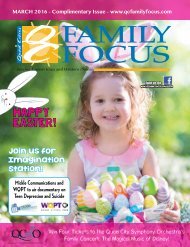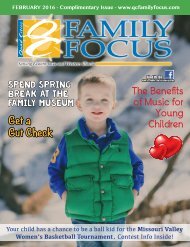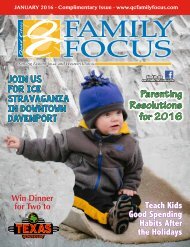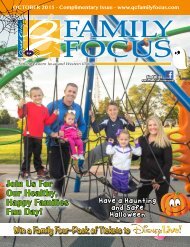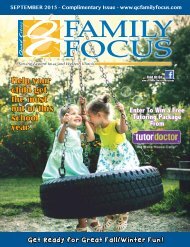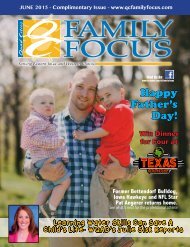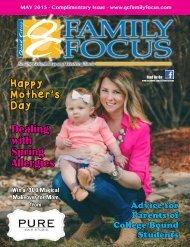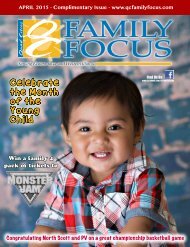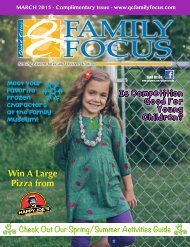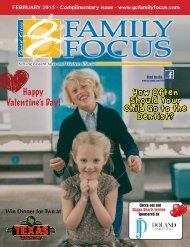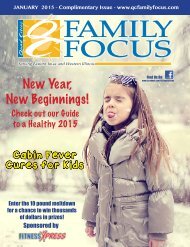QC Family Focus: November 2015
In this issue: A Teen's Perspective on Volunteering; 5 Tips for Helping Your Baby Develop; Reading with Infants and Toddlers; Text Neck: It's a Real Deal; Putnam Museum Boosts Holiday Offerings; Your Child's First Dental Appointment; Kids and Savings; The Importance of Music Education; Shoveling without Damaging Your Spine; The Facts About Fats; Senior Lifestyles; Learn more about QC Family Focus Magazine at our website: www.qcfamilyfocus.com Like us on Facebook: www.facebook.com/qcfamilyfocus
In this issue:
A Teen's Perspective on Volunteering;
5 Tips for Helping Your Baby Develop;
Reading with Infants and Toddlers;
Text Neck: It's a Real Deal;
Putnam Museum Boosts Holiday Offerings;
Your Child's First Dental Appointment;
Kids and Savings;
The Importance of Music Education;
Shoveling without Damaging Your Spine;
The Facts About Fats;
Senior Lifestyles;
Learn more about QC Family Focus Magazine at our website: www.qcfamilyfocus.com
Like us on Facebook: www.facebook.com/qcfamilyfocus
Create successful ePaper yourself
Turn your PDF publications into a flip-book with our unique Google optimized e-Paper software.
Brenda Boleyn, Ph.D. & Barbara Wiese, Ph.D.<br />
Professors in the School of Education<br />
at St. Ambrose University<br />
The benefits of reading with children emerge very<br />
early in life. To start, the act of sharing books with someone<br />
they love helps infants and toddlers learn to love reading, too!<br />
It also helps them learn new words, as well as the form of<br />
language used in writing—book language is more formal than<br />
spoken language. Reading encourages them to explore new<br />
ideas and think about things they may not have experienced<br />
yet. It helps them understand that pictures and print are<br />
symbols and represent or stand for something, and they also<br />
come to understand why people read, what they read, and how<br />
books work.<br />
Let’s talk first about the word, “reading.” What does<br />
reading with an infant or toddler look like? What does it sound<br />
like? We know it is a totally different experience from how adults<br />
or school-age children read. Appropriate reading behaviors<br />
when talking about infants and toddlers might include: chewing<br />
books, opening and closing a book repeatedly, treating books<br />
as toys, imitating an action in a picture they see, or repeating<br />
a word they hear the adult read. Reading does NOT generally<br />
mean the infant or toddler quietly and attentively listens while<br />
sitting still in one spot for 30 minutes, or that every word on<br />
every page gets read (State of Iowa, Department of Education,<br />
Every Child Reads, 2005).<br />
Let’s think next about the second word in our title—<br />
“with.” It is important to think of reading as an activity you do<br />
WITH young children, rather than TO young children. Sharing<br />
a book is like having a conversation. A strategy you can use to<br />
facilitate a discussion around a book with a very young child is<br />
the CAR strategy—C stands for comment. There are several<br />
kinds of comments you can make. You can point at what your<br />
child is looking at and name it, describe the picture your child<br />
is looking at, or connect the picture or story to something<br />
familiar in the child’s life. A stands for ask questions. When<br />
you ask questions, you want to limit your questions to one at<br />
a time, keep them short and simple, and use words you think<br />
your child already understands. Finally, R stands for respond,<br />
and add a little more information. For instance, if you are<br />
reading to your child and you notice her getting excited when<br />
looking at the kitten in the picture, you would do more than<br />
point and say, “kitty.” Instead you might say, “Yes, that is a<br />
kitty! He’s sitting under the table.”<br />
Reading<br />
with Infants<br />
and Toddlers<br />
Other helpful suggestions to encourage your infant/<br />
toddler to listen and respond to the books you share include:<br />
reading with enthusiasm, using different voices for different<br />
characters, varying the loudness of your voice and the speed with<br />
which you read, making the sounds of things you are reading<br />
about—encouraging your child to do the same, and using<br />
different facial expressions and gestures—again, encouraging<br />
your child to do the same (State of Iowa, Department of<br />
Education Early Childhood Services Bureau, 2009).<br />
The strategies we’ve discussed for sharing books<br />
will be far more successful if you start with the right kind of<br />
books. Following are some guidelines taken from Tips for<br />
Choosing Books for Babies and Toddlers (2011), found on the<br />
ZerotoThree.org website. This website is a wonderful resource<br />
on a variety of topics regarding children from birth to age three.<br />
Infants 0-6 months:<br />
● Books with simple, large pictures or designs with bright<br />
colors.<br />
● Stiff cardboard, “chunky” books, or fold-out books that can be<br />
propped up in the crib.<br />
● Cloth and soft vinyl books with simple pictures of people or<br />
familiar objects that can go in the bath or get washed.<br />
Infants 6-12 months:<br />
● Board books with photos of other babies.<br />
● Brightly colored “chunky” board books.<br />
● Books with photos of familiar objects like balls and blankets.<br />
● Books with sturdy pages that can be propped up or spread out<br />
in the crib or on a blanket.<br />
● Plastic/vinyl books for bath time.<br />
● Washable cloth books to cuddle and mouth.<br />
● Small plastic photo albums of family and friends.<br />
Toddlers 12-24 months:<br />
● Sturdy board books that they can carry.<br />
● Books with photos of children doing familiar things like<br />
sleeping or playing.<br />
● Goodnight books for bedtime.<br />
● Books with only a few words on each page.<br />
● Books with simple rhymes or predictable text.<br />
Toddlers 2-3 years:<br />
● Books that tell simple stories.<br />
● Simple rhyming books that they can memorize.<br />
● Books about counting, the alphabet, shapes, or sizes.<br />
● Animal books, vehicle books, books about playtime.<br />
● Books with their favorite TV characters inside.<br />
Research has found that children who are read<br />
with often from an early age usually enter school with more<br />
advanced language and better listening skills than those who<br />
have not had the same experience (Greenberg, J., Parrish, H.,<br />
and James, C., 2008). They also have an easier time learning<br />
to read independently when they begin school (Newman, S. B.,<br />
2002). If your child is one week, one month, one year old, or<br />
older, read with him/her. It is never too early (or late!) to start!<br />
<strong>QC</strong> <strong>Family</strong> <strong>Focus</strong> - <strong>November</strong> <strong>2015</strong> 11




